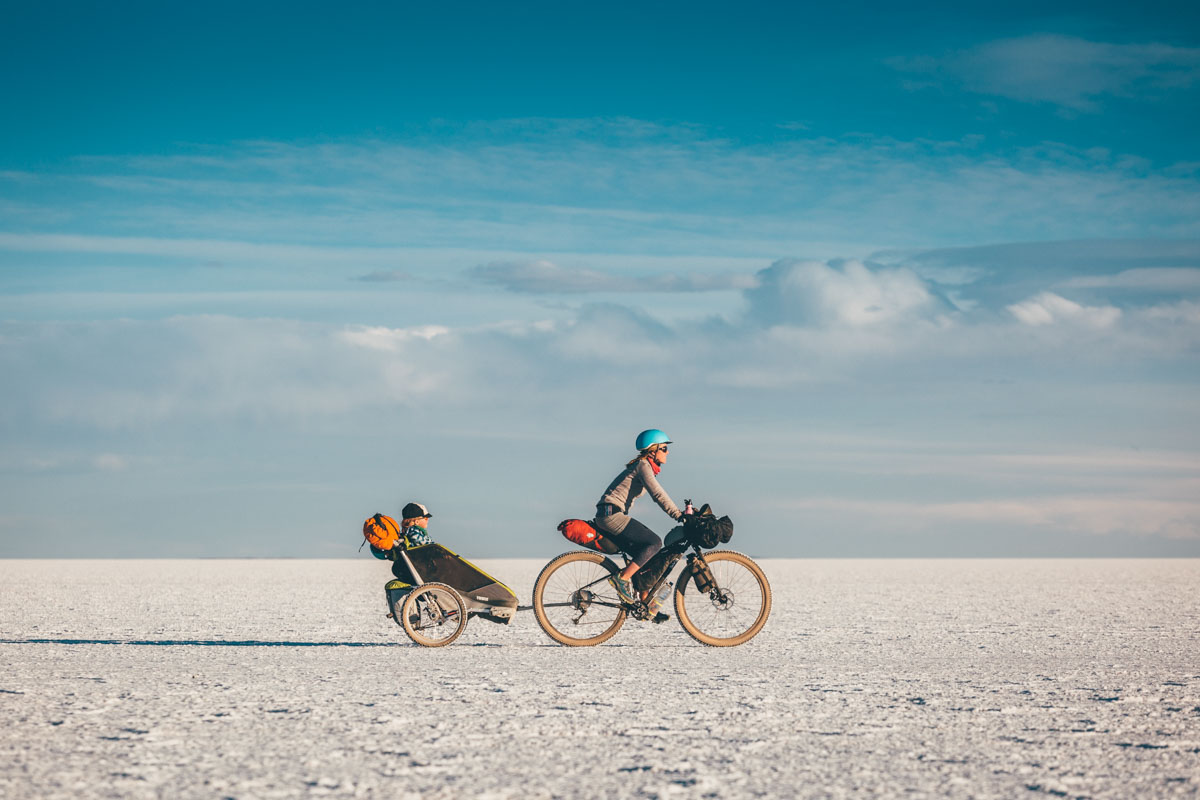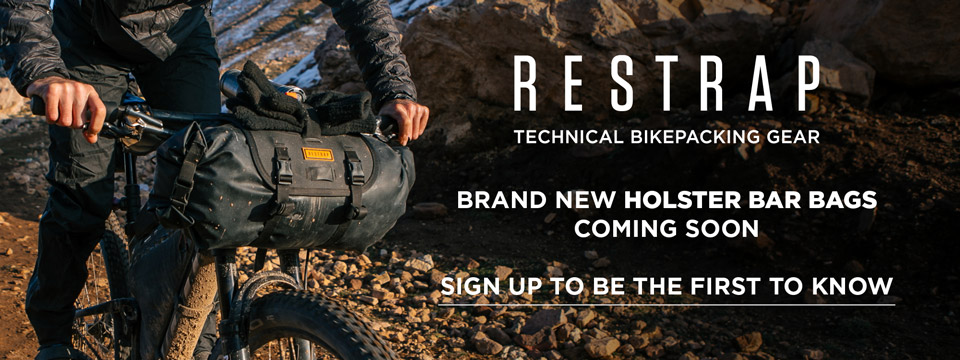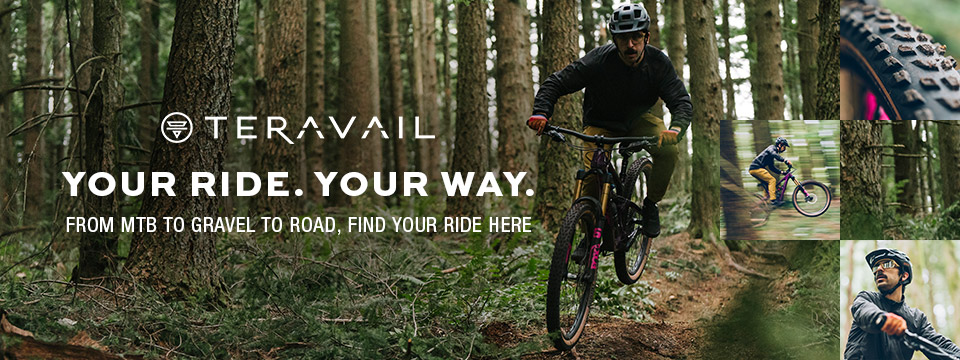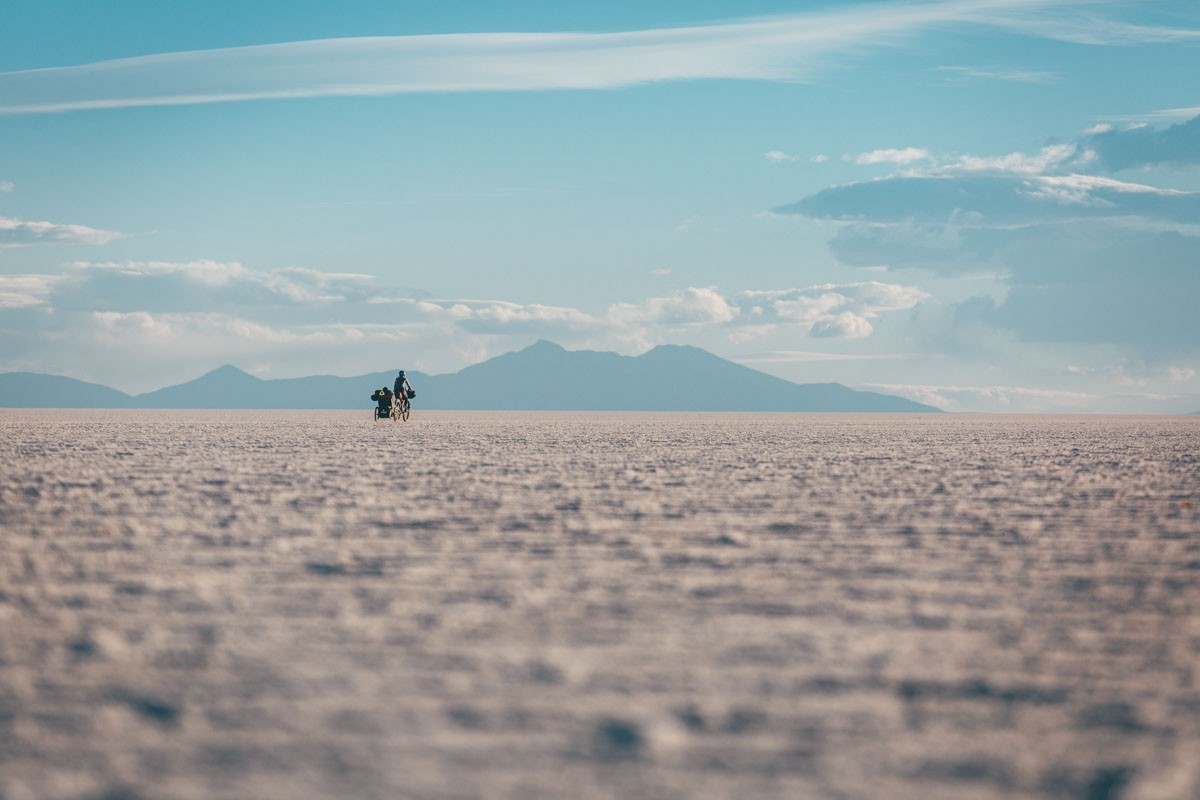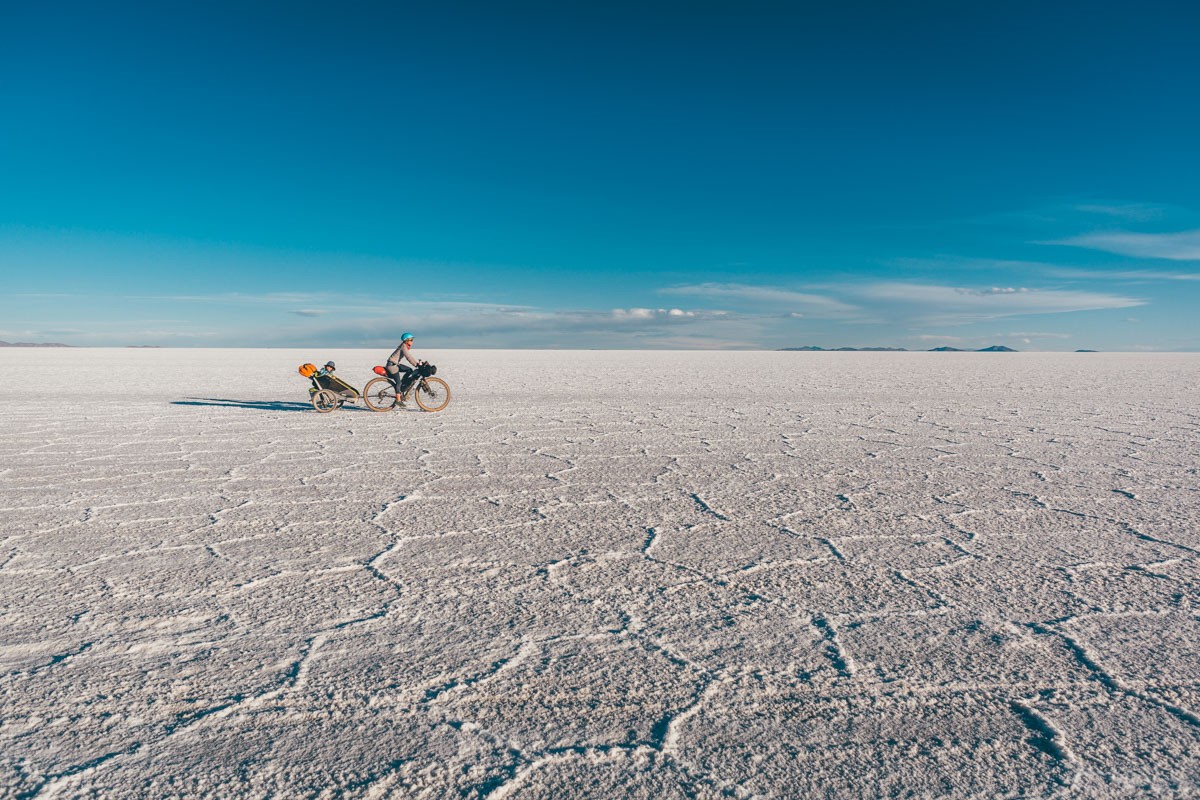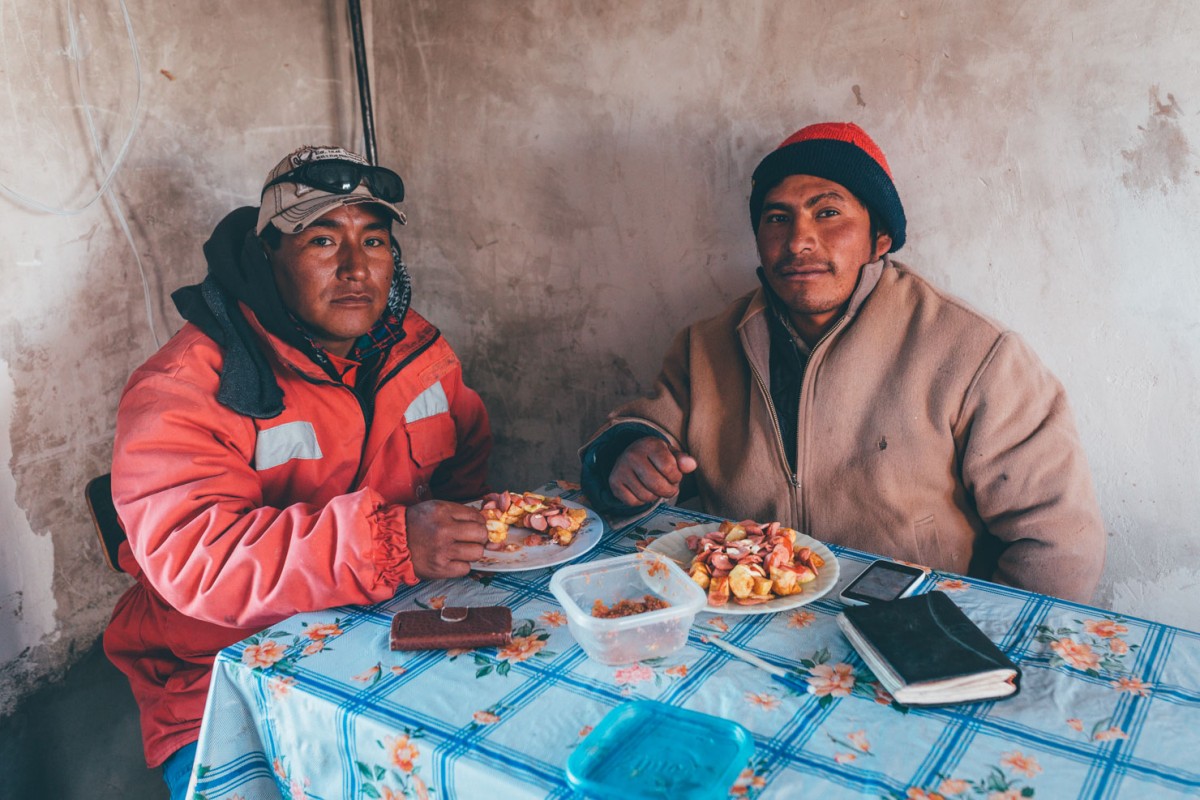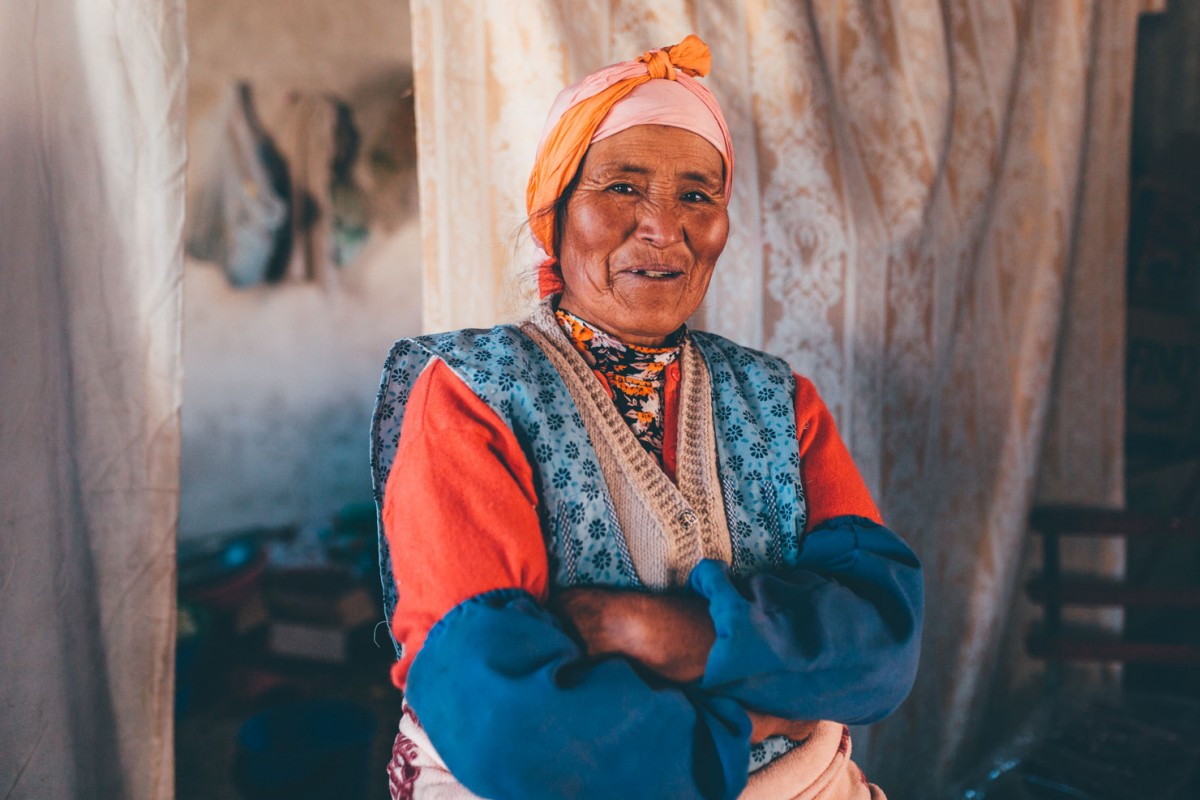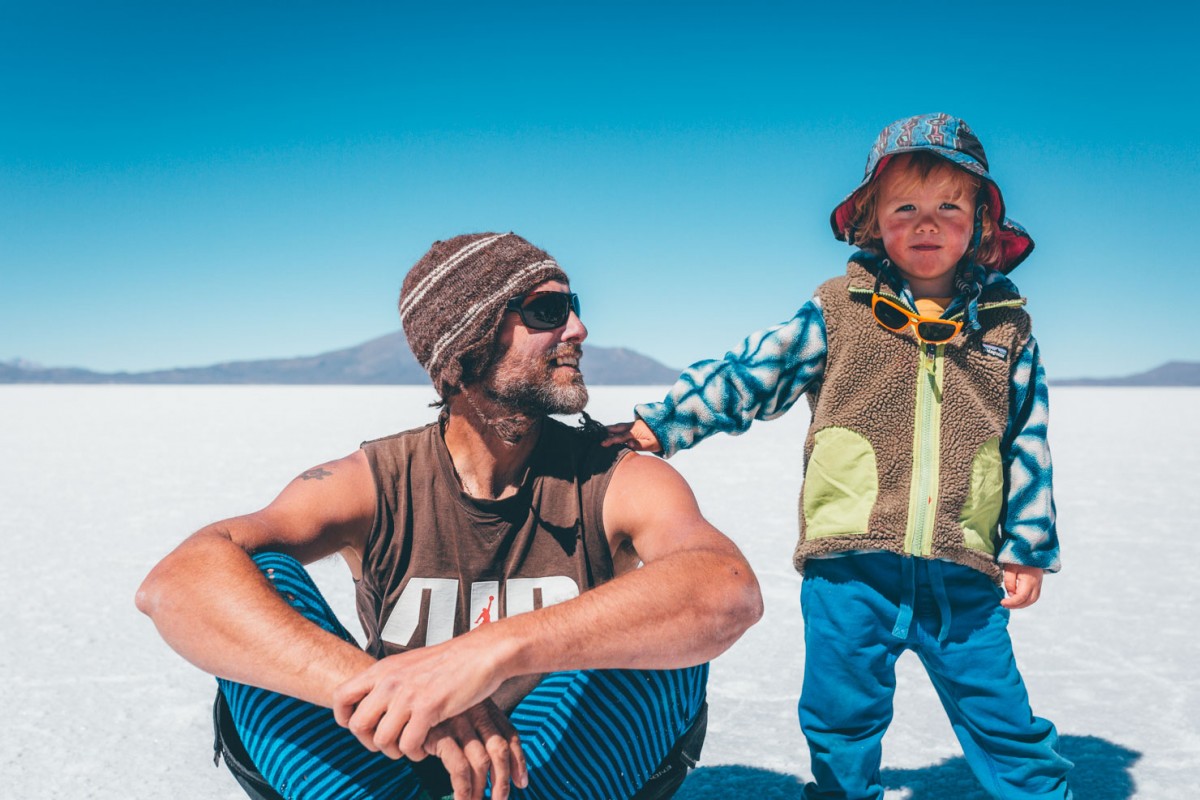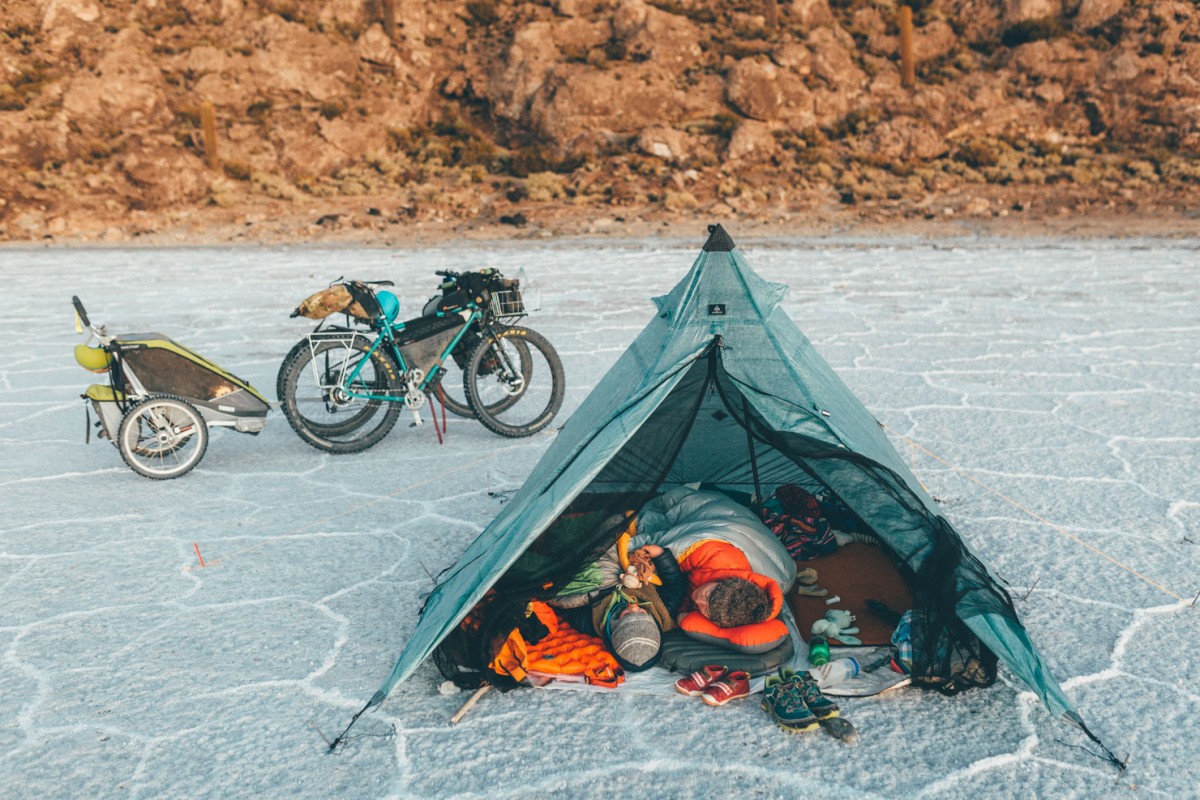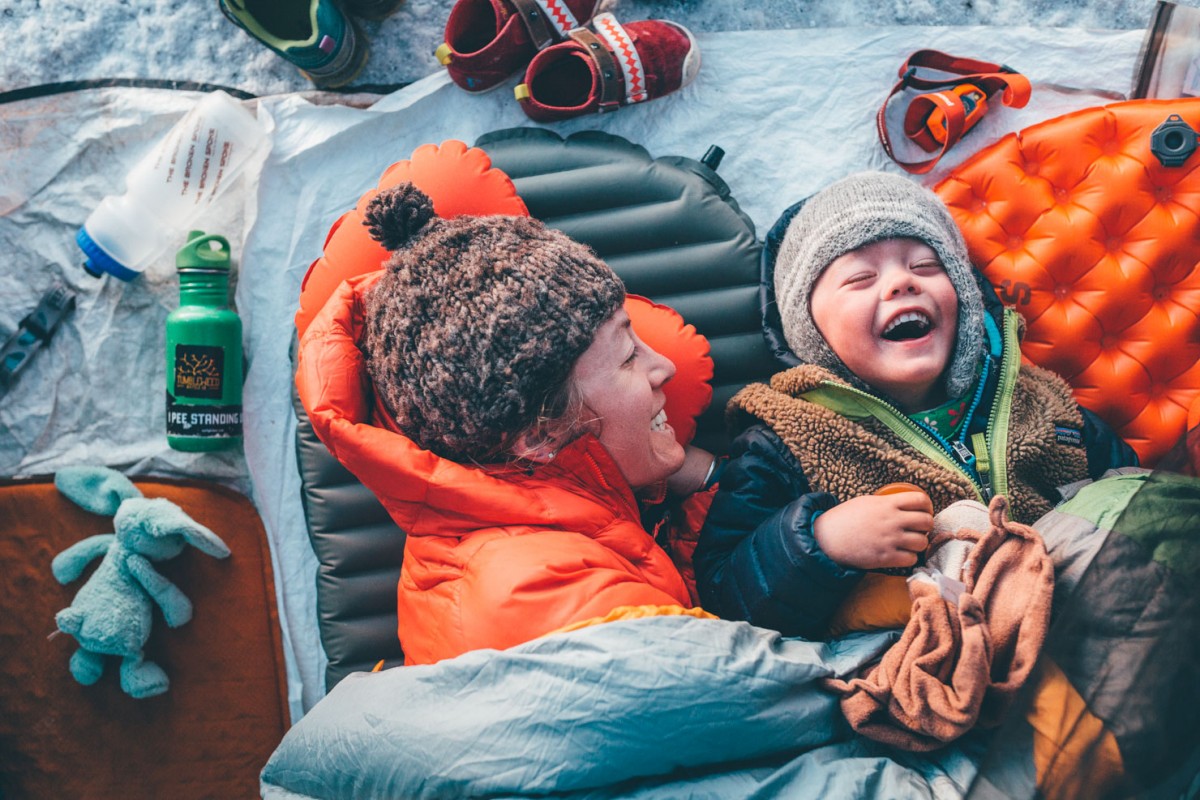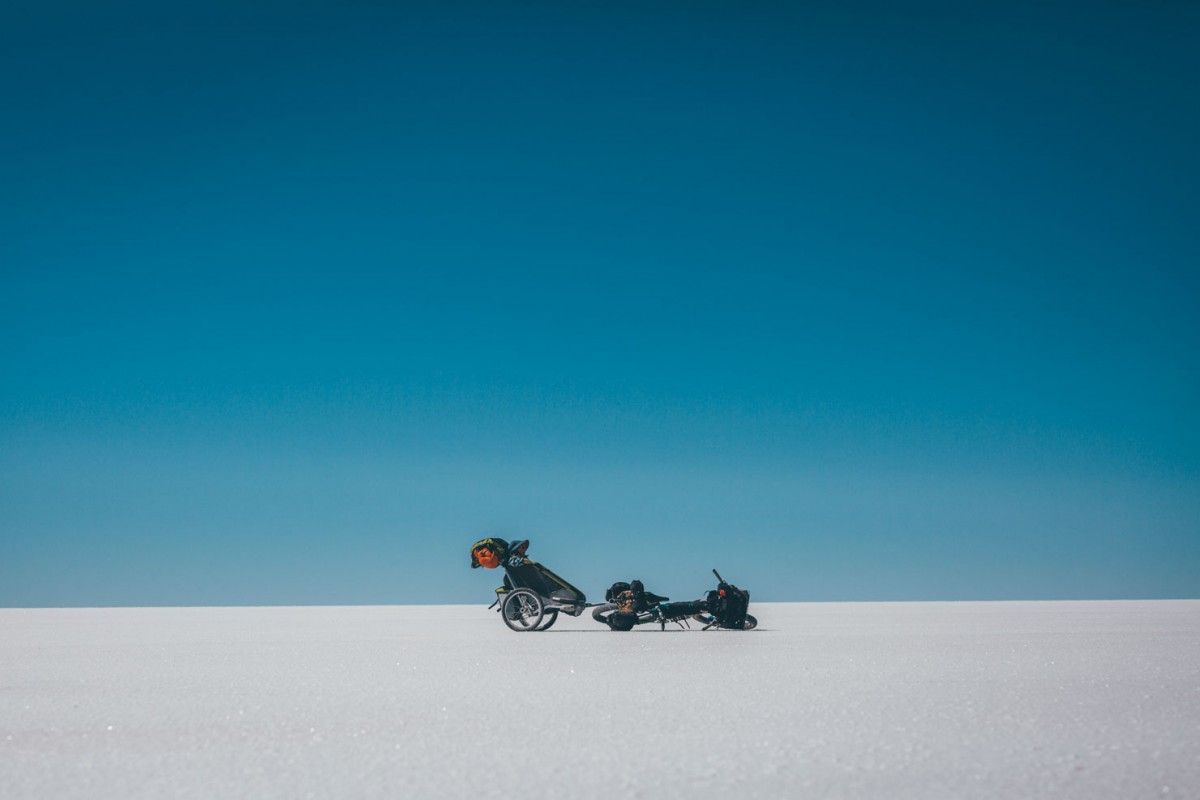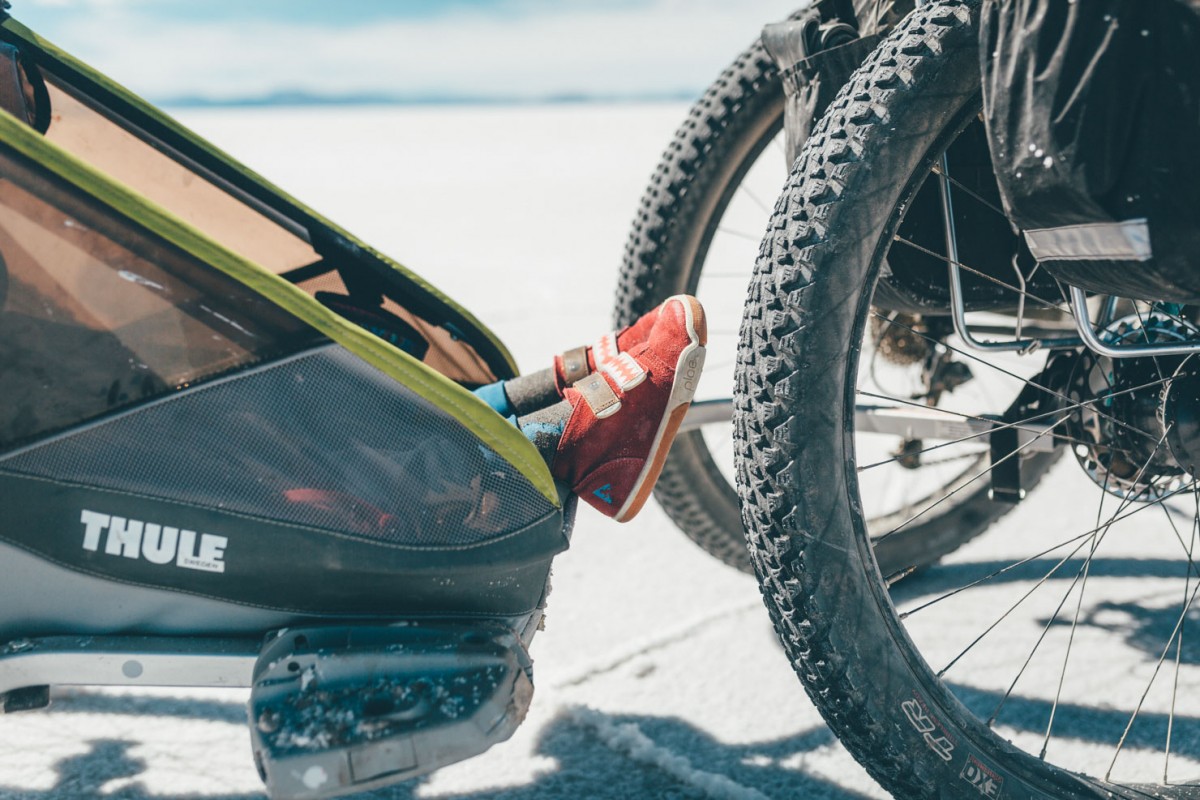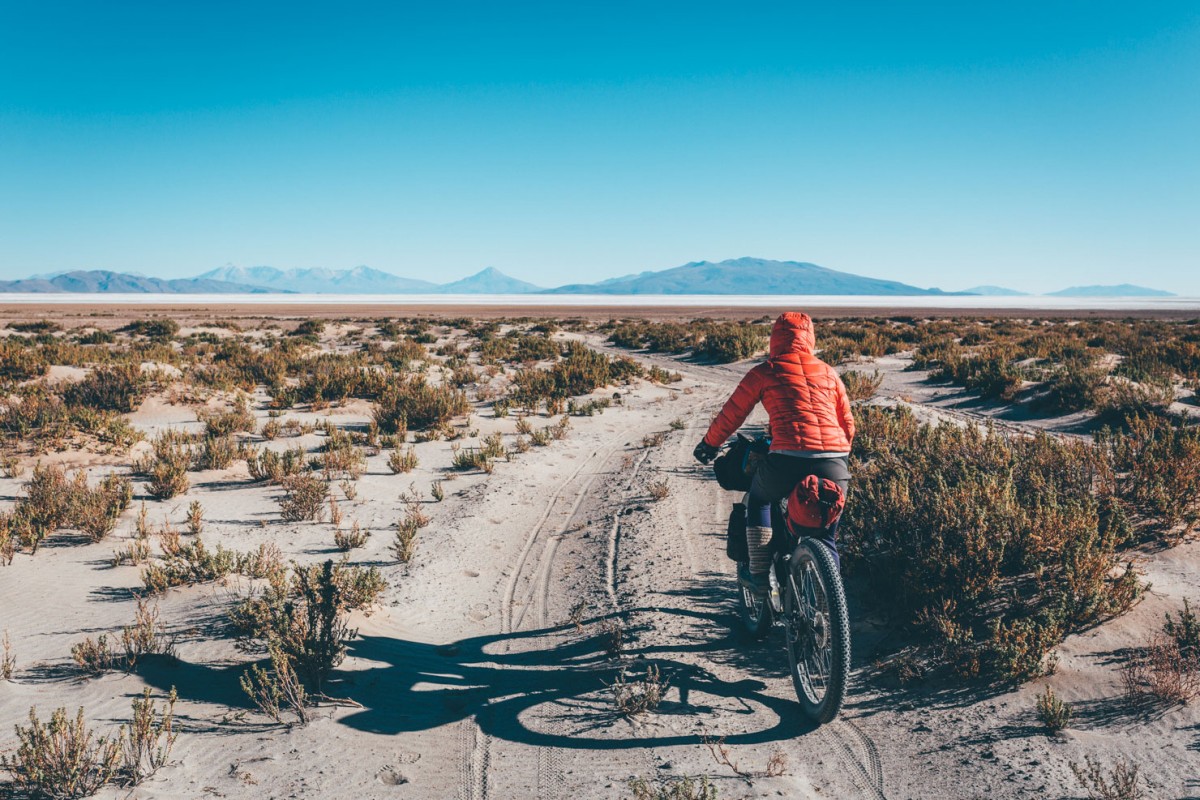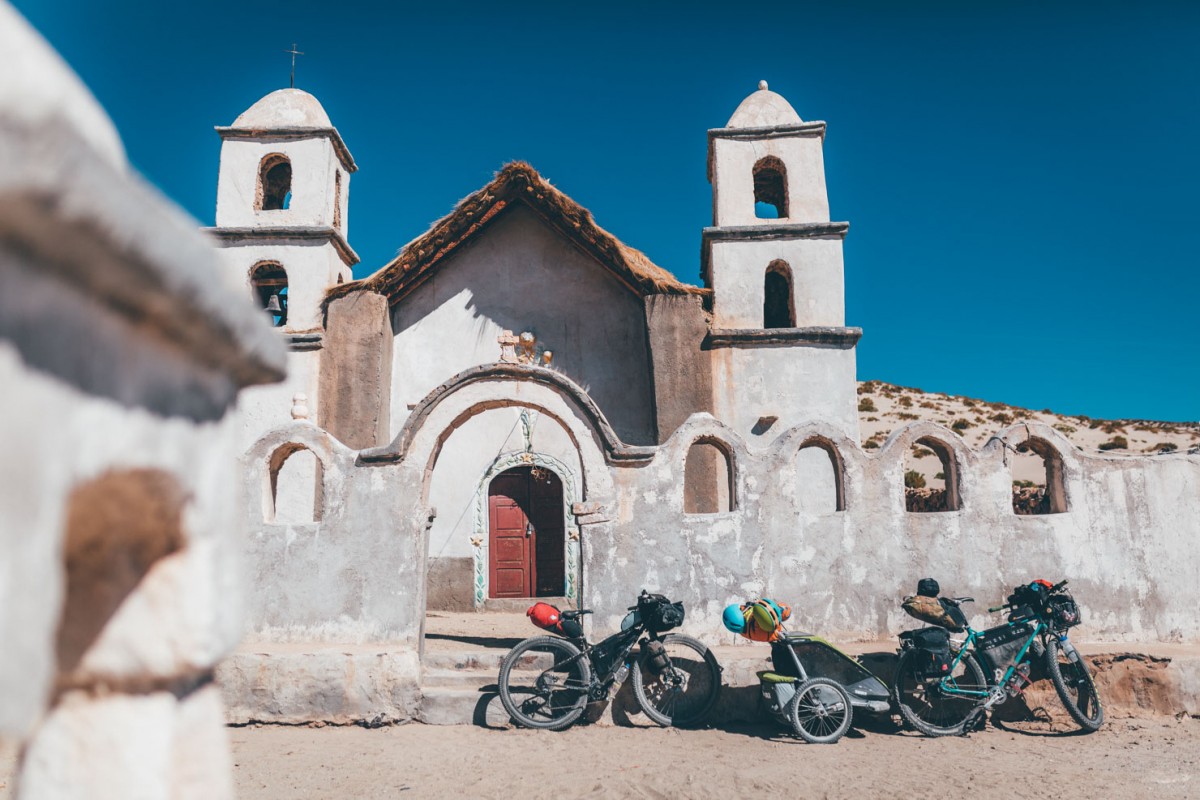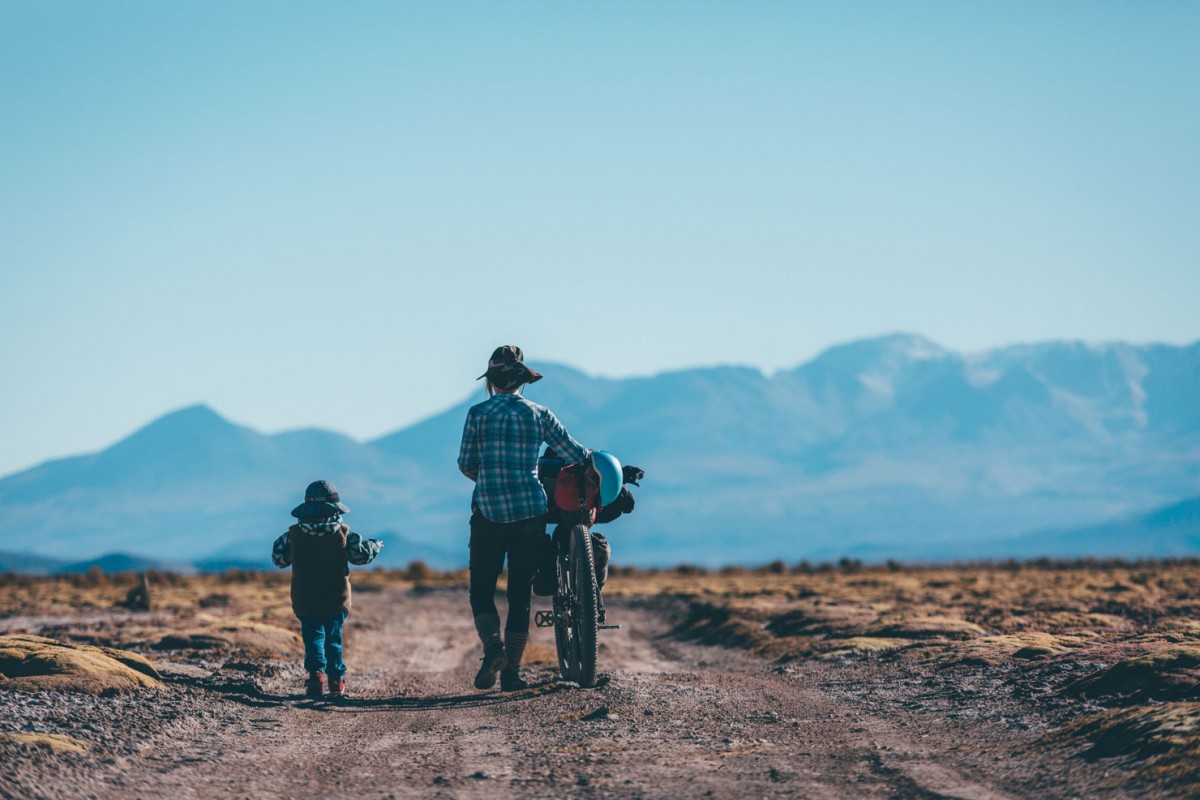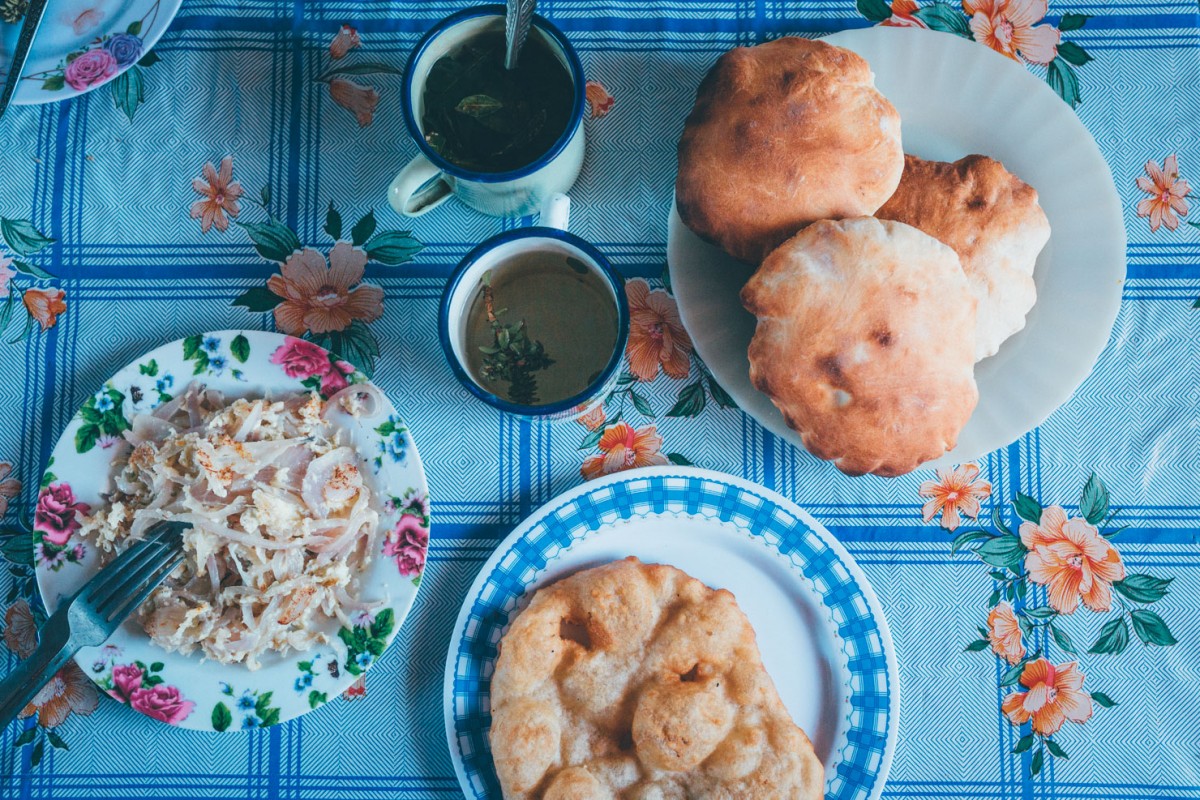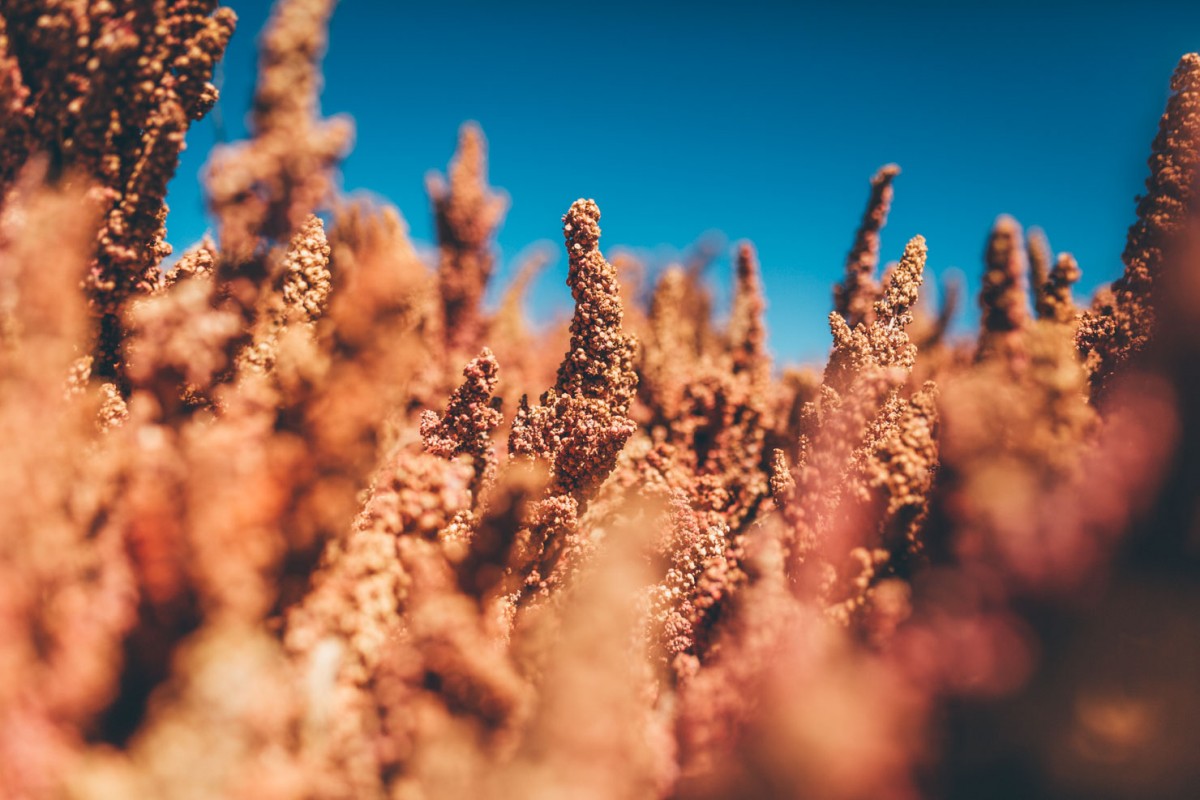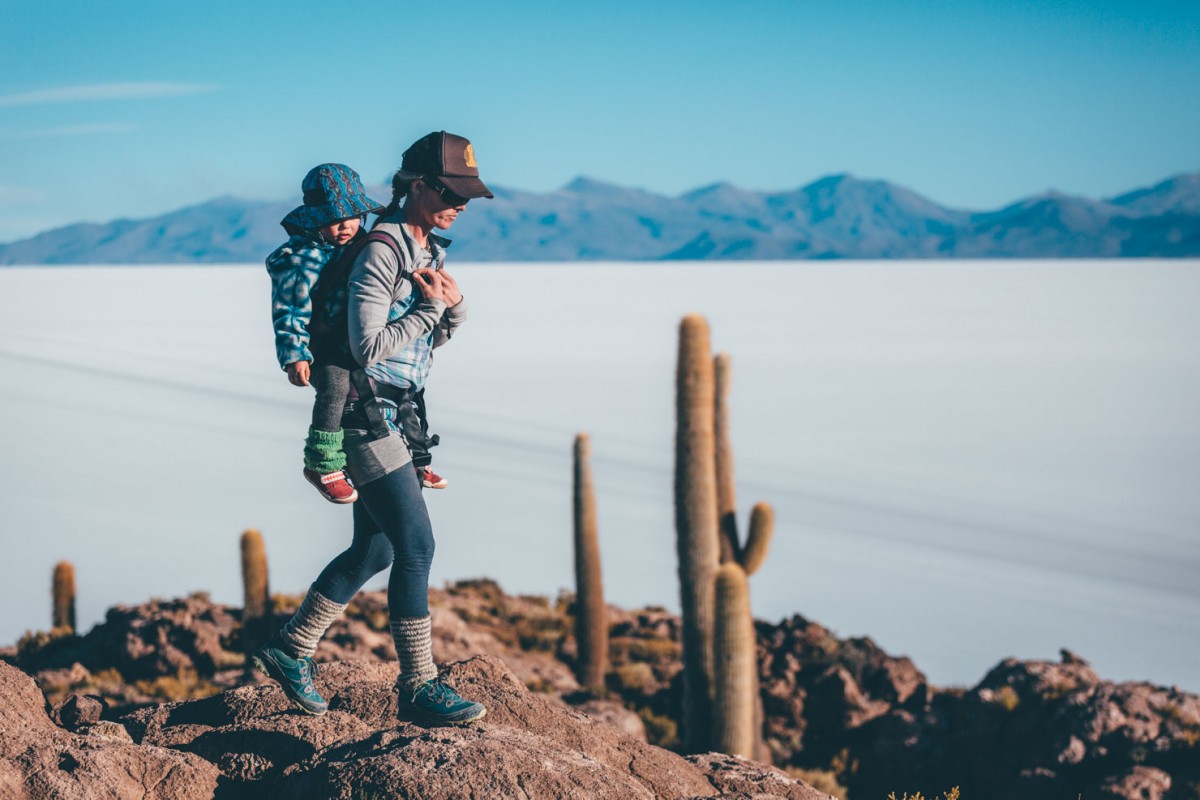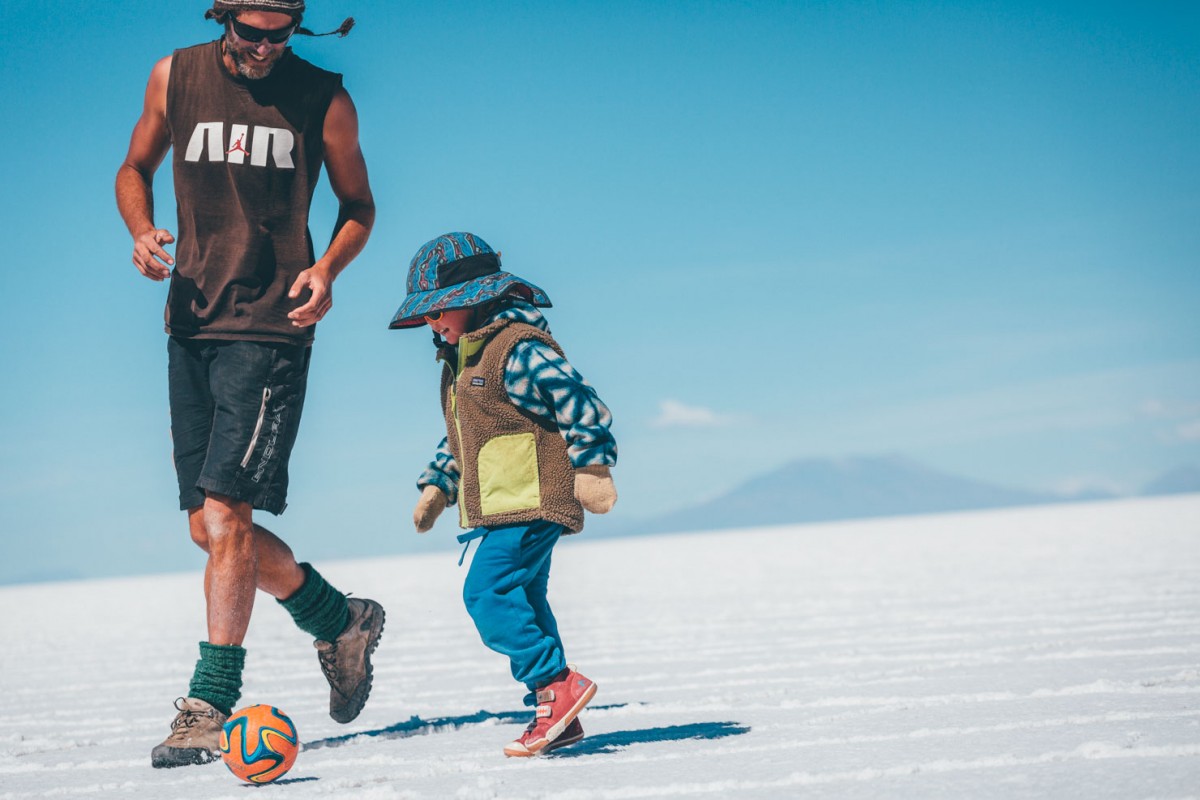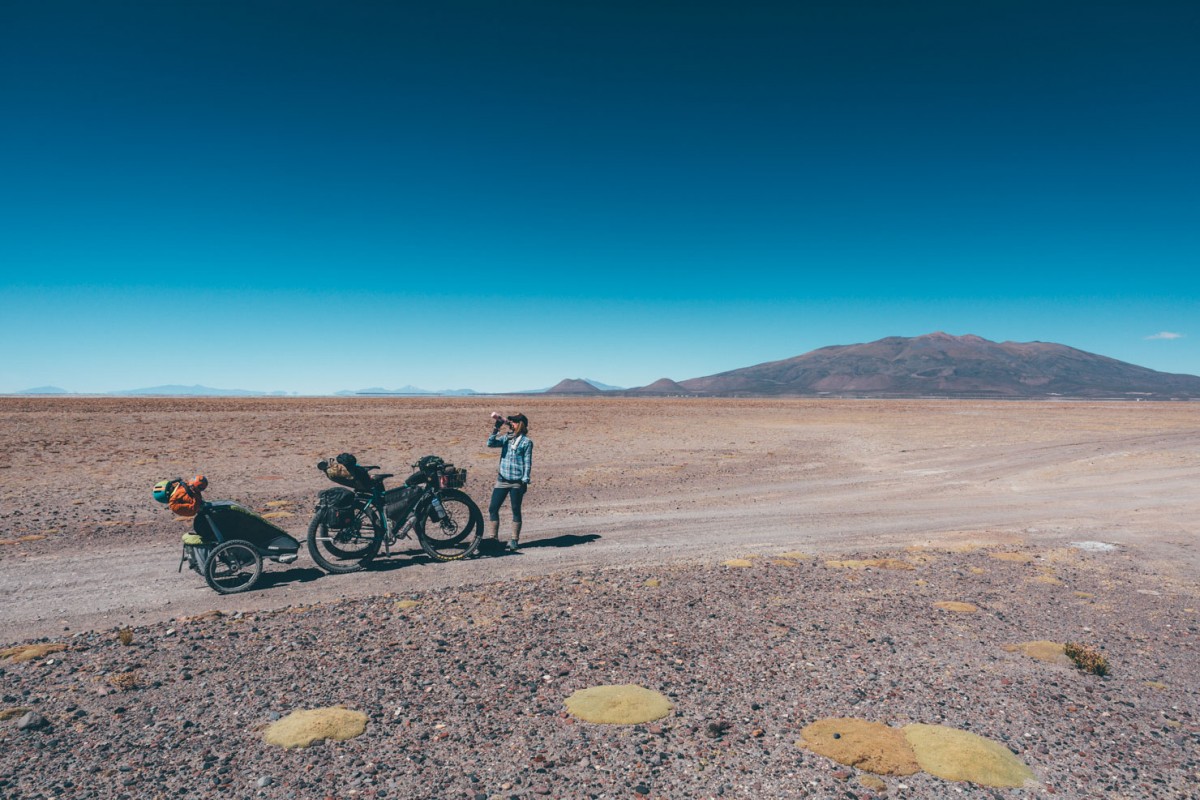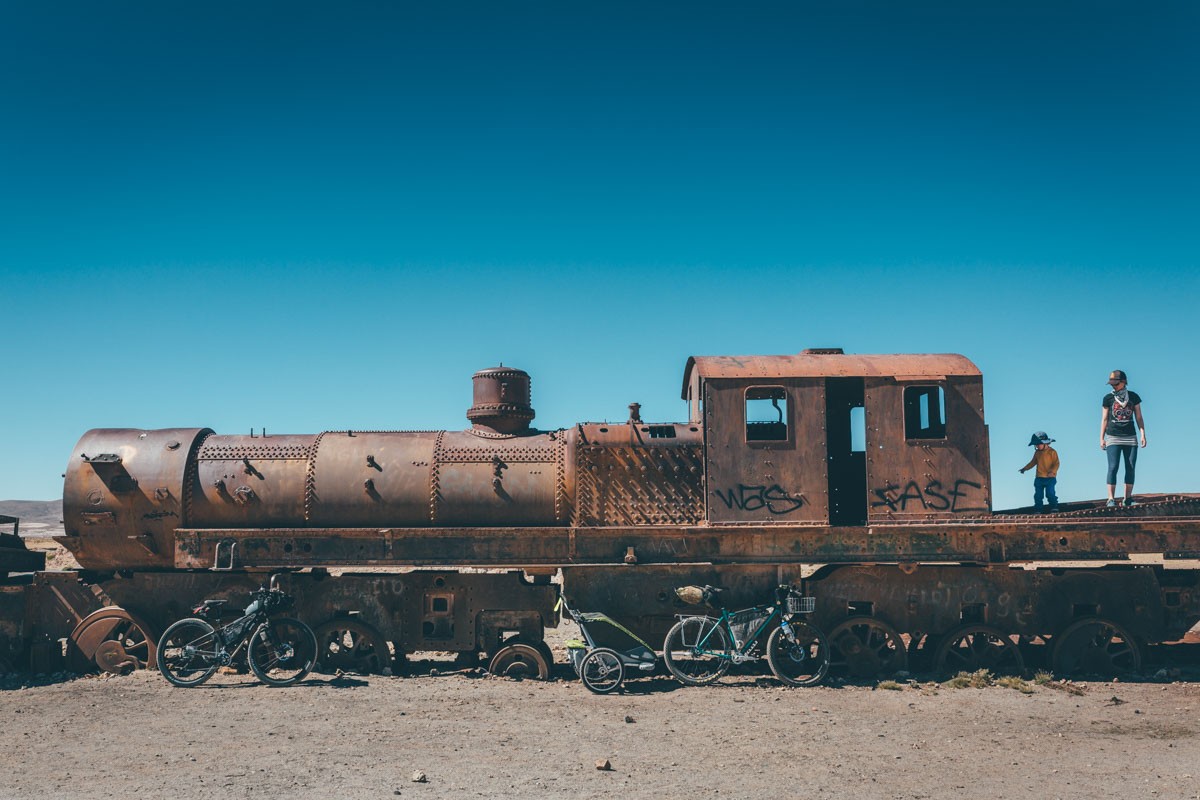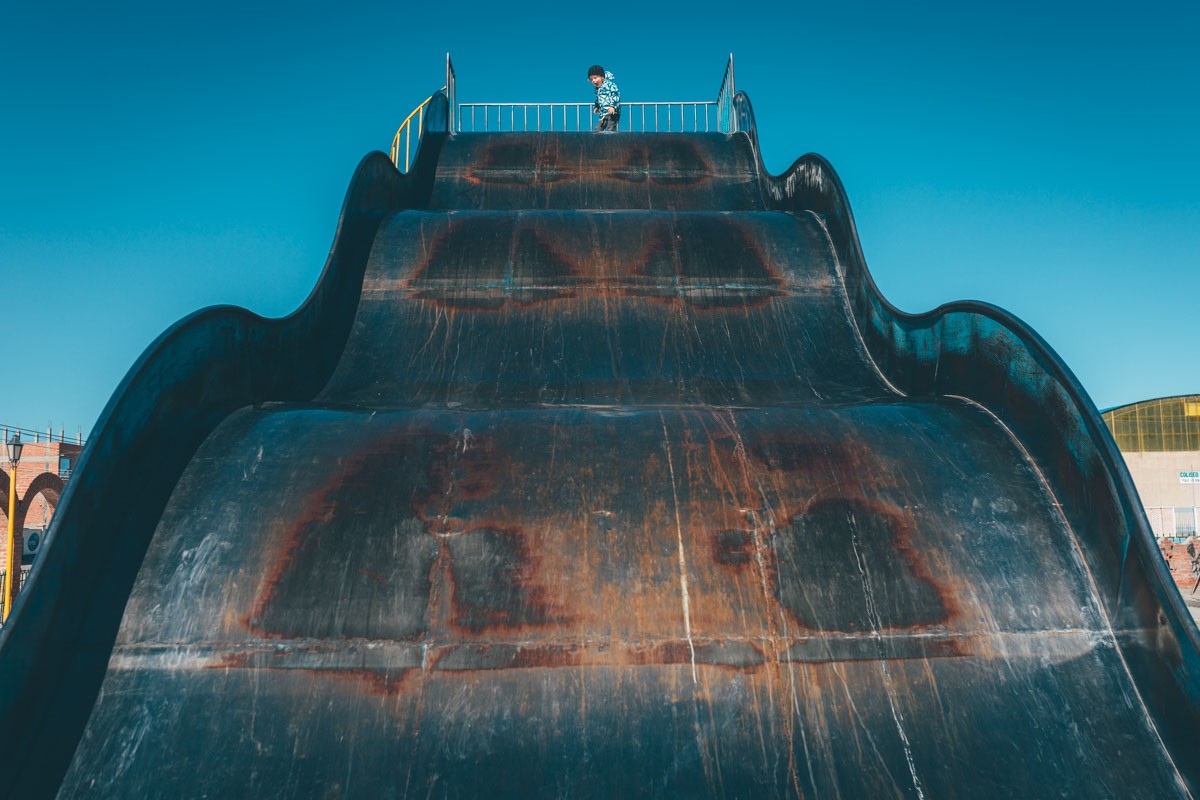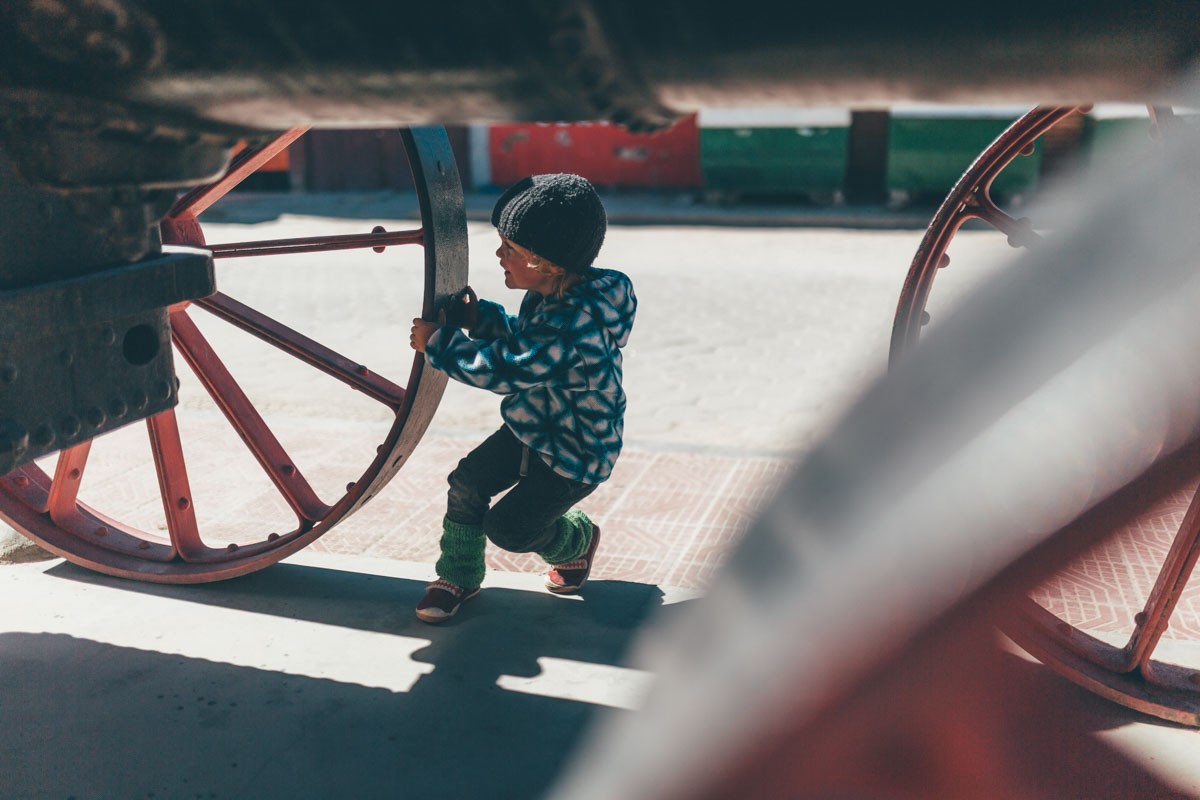Salt of the Earth: A Family Adventure in Bolivia
Cycling atop the salt crust of Bolivia’s iconic Salar de Uyuni – and the more petite but perfectly formed Salar de Coipasa – is an undisputed highlight of many a South American journey. Two years ago, I traversed their high altitude, bleached white canvases. This year, I returned with my family…
PUBLISHED May 25, 2016
For as almost as long as I can recall, traversing Bolivia’s salt flats had been a bike touring dream, sparked by images I once saw of a tribe of bearded, rag tag bike travellers pedalling across its open, featureless breadth. Two decades later, when I embarked on a mission to cycle across the length of the Americas, experiencing the Salar was the motivating factor that kept me going. And it was the place I chose to return to with my family, so they might also experience this wondrous, surreal and extreme land.
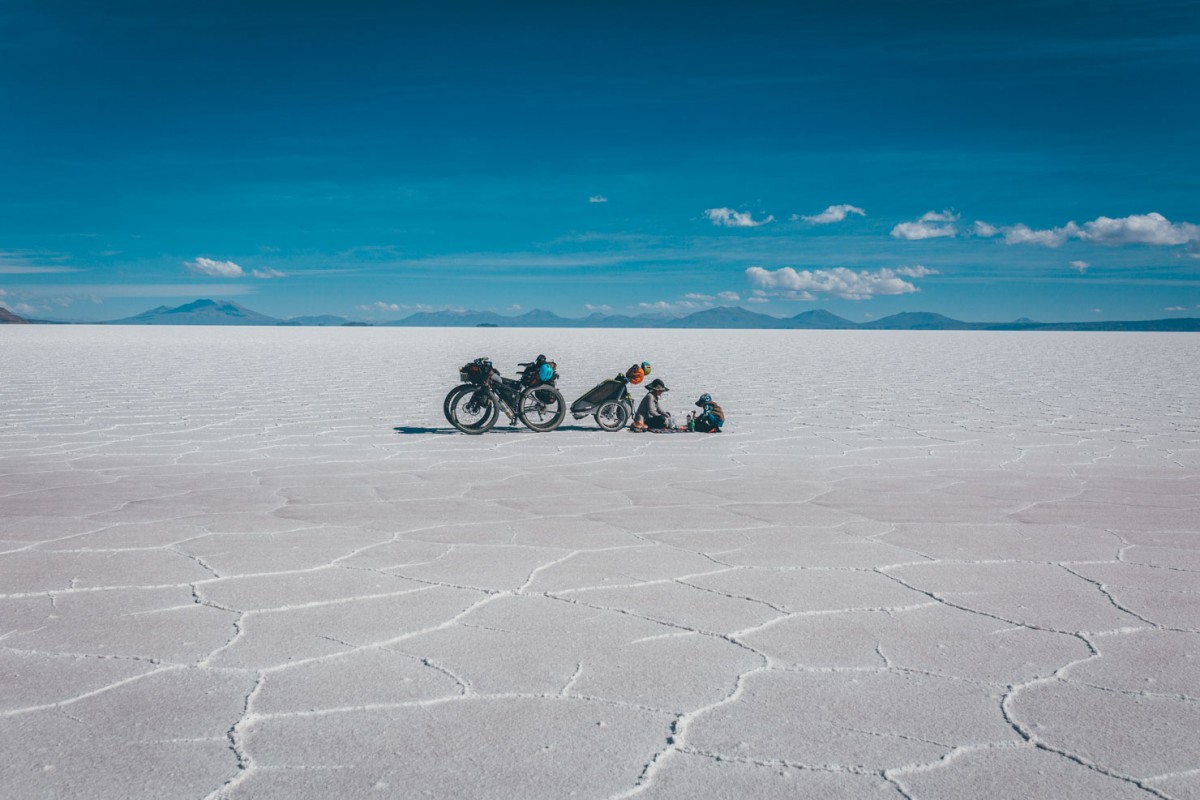
Granted, Bolivia might not seem the most obvious choice for a family holiday, especially the high altitude Altiplano, perched at 12,000ft and above. The backroads are corrugated and sandy. The sun is relentless. Food is limited and water is scarce. And living conditions are distinctly basic.
But beneath this challenging veneer, the Bolivian high plateau is undeniably beautiful, rich in history and, despite the harshness of its environment, a welcoming place too. Wherever we’ve been, we’ve received open hearted generosity. Sage has scooped into the arms of passers by (not, to be honest, his favourite pass time) and gifted an endless supply of lollies and cookies (much to his health conscious mother’s chagrin).
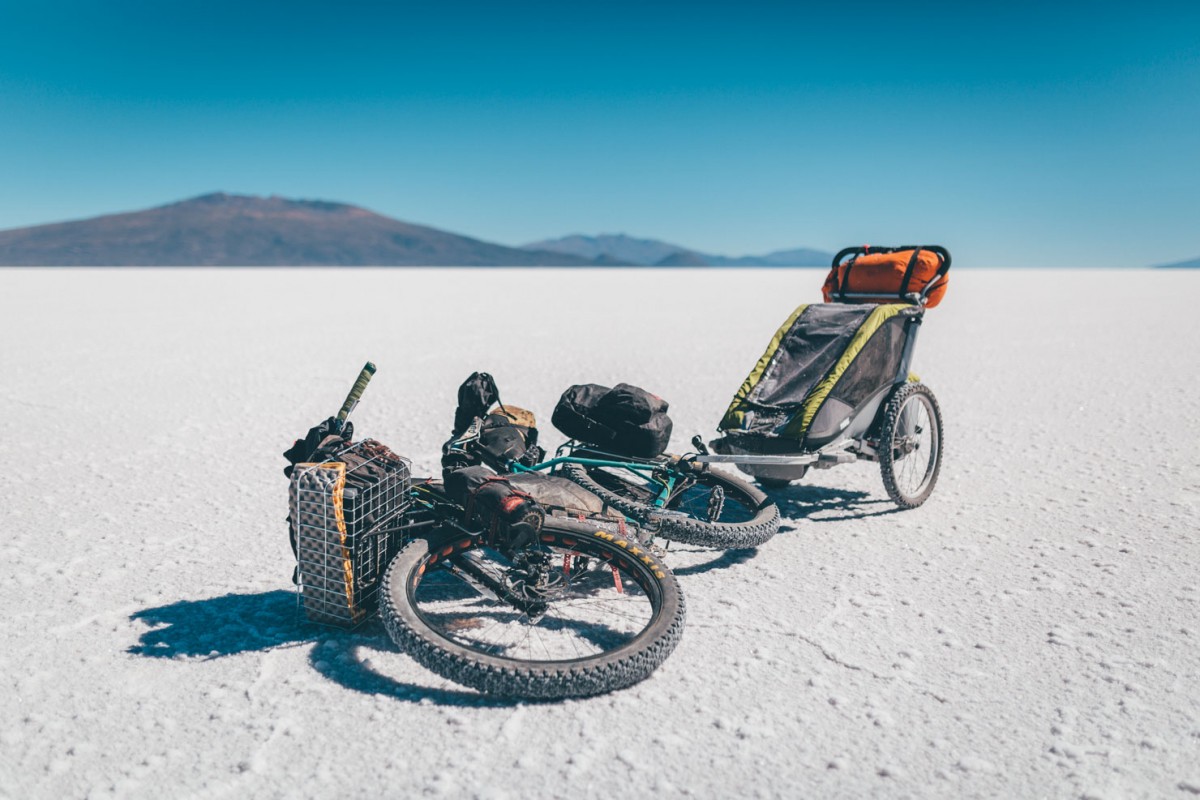
For this trip we zoned straight in on the wilder, south west region of the country, using public transport to escape the somewhat precarious driving on Bolivia’s paved highways. Our ride began in the settlement of Sabaya, gateway to the Salar de Coipasa – the smaller, more compact sibling to the neighbouring and more celebrated Salar de Uyuni.
It wasn’t long before we had our first taste of altiplano hospitality. Amongst international cycle tourers crossing the Salar, Petrolina is a one woman institution. She runs a small restaurant in the forlorn village of Coipasa – where llamas outnumber people and dust swirls around empty streets. There, she scoops up passing cyclists, sits them down in her cozy establishment, and feeds them until they are close to bursting. As she did with us. We even stayed the night in her house and had our bellies filled the next morning – all for just a handful of Bolivianos. Not having any children of her own, Petrolina was particularly enamoured with Sage, gifting him an enormous platter of salchipapas – processed sausages and mayonnaise-drenched french fries, a Bolivian staple – when it was time for us to leave. We bought two beautiful hats she’d made from alpaca wool as a memory of our time with her. In return, she treated us to one of her best gap-toothed smiles.
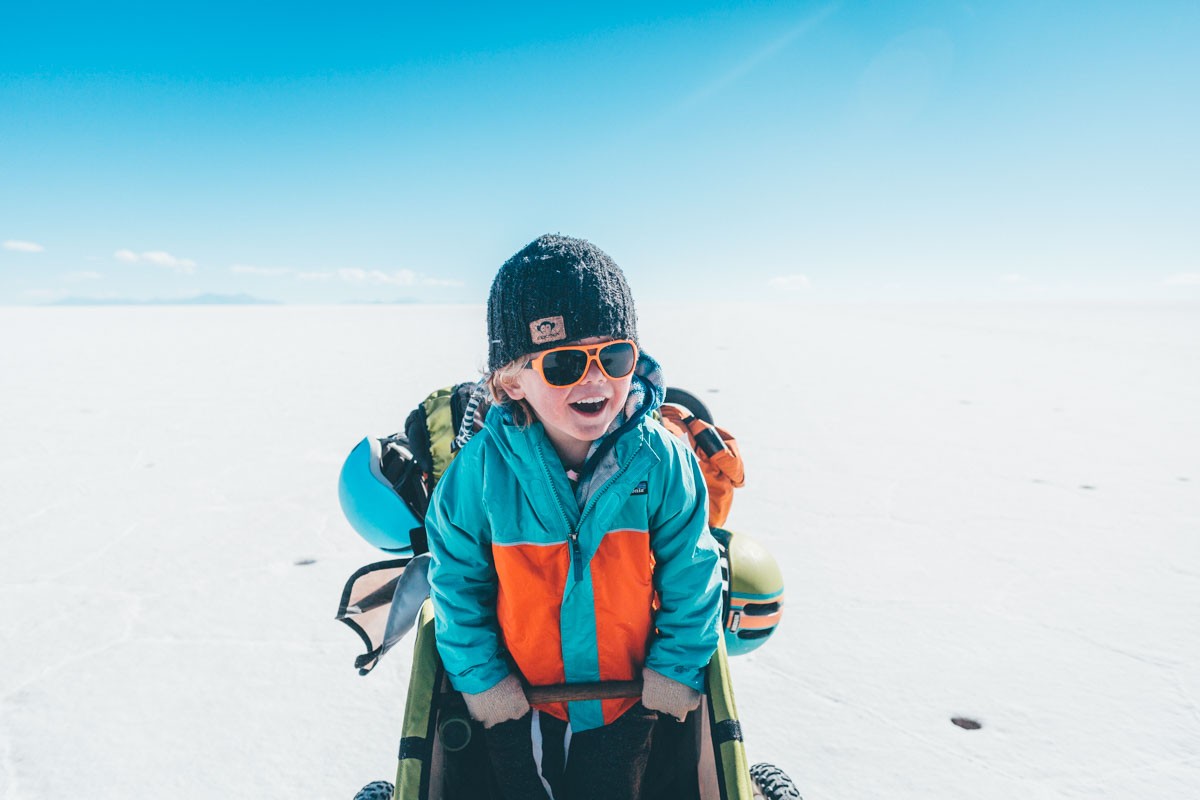
Being the cusp of winter, there was a chill in the air as we left dry land and headed out onto our first salar. The shallow edges of these ancient lakes have a spongy crunchiness to them. Under their crust they hide reservoirs of lithium-rich brine: in fact, close to half the world’s lithium deposits are to be found in this region. At present, most of the local industry is geared towards salt production, but plans to ramp up lithium extraction are in the works… who knows how this untouched land will look in the next decade. Encircled by distant volcanoes, the salar itself resembled a bleached white canvas that glittered in the afternoon sun, salt crystals paving our way like diamonds. It was an otherworldly realm we had all to ourselves – we didn’t see another soul during the day it took us to cross its expanse, reaching a dirt road on the other side by late afternoon.
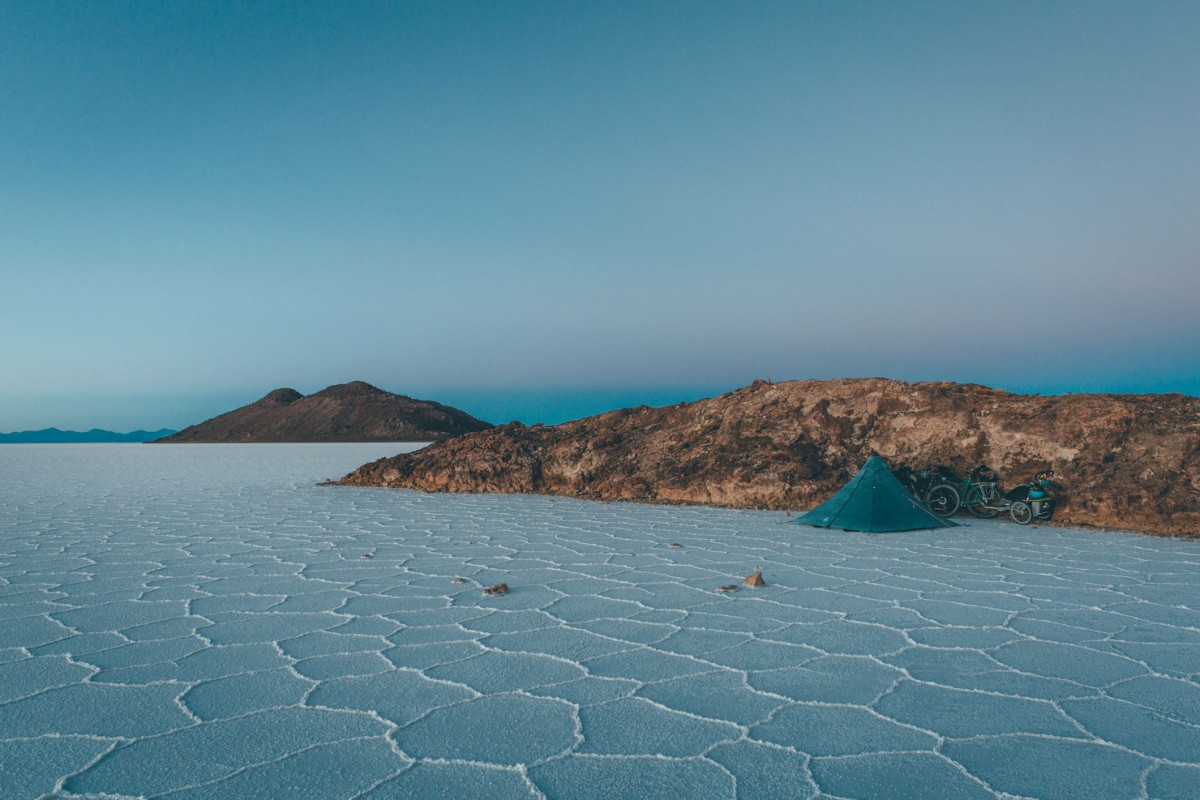
From here, the going was harder; deep sand in places and corrugation mined the dirt roads found across this finger of land, linking the Salar de Coipasa with that of Uyuni. Again, despite this challenging terrain, hospitality prevailed. When I flagged down a motorbike rider to check on road conditions ahead, we were immediately invited into his home in Ventilla, a tiny desert hamlet populated by just a few families of quinoa farmers and llama herders. That night we were treated to thoughtful conversation over a hearty serving of these wholesome, organic grains. Our host insisted we take his room, and in the morning, his wife served us up a ‘caldo’ – a delicious quinoa and llama soup – to fuel us for the ride ahead.
Onwards we rode. To break up the day, and make sure Sage isn’t always confined to the cocoon of his trailer, sometimes we stopped to play football. Or we paused to creep up on llama, noble animals that observed us with as much interest as we watched them. Or we enjoyed long, protracted rounds of chase; hopping, skipping and jumping away from each other, an unending game given the boundary-free altiplano. Or we simply walked the bikes for a while. Walking brings out conversation. At the tender age of three, Sage is becoming quite the storyteller. His arms dance and his fingers wiggle as he chats excitedly. I love hearing him link up sentences and ideas… word by word, like a tightrope walker placing one foot in front of the other.
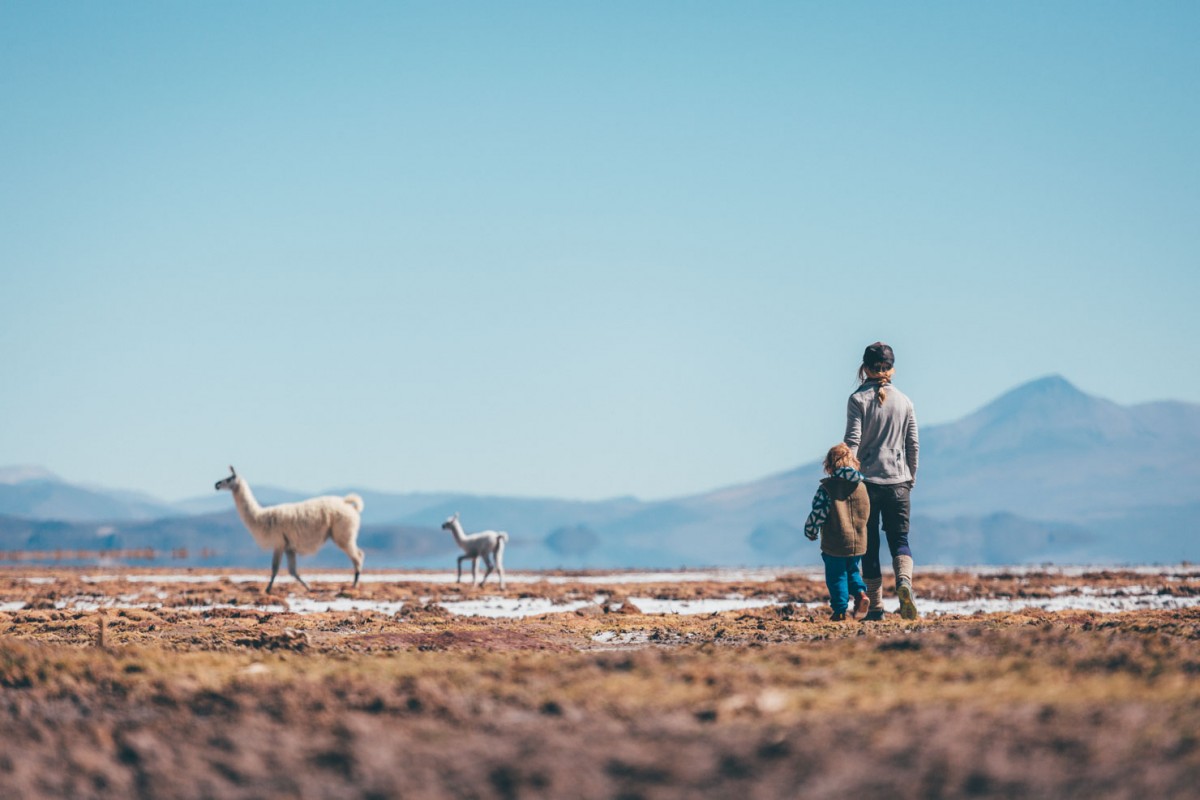
In Llica, the main settlement between the salt lakes, we met two young couples in the midst of long distance bike touring odysseys – one from France, on solo bikes, the other from Switzerland, piloting a tandem. The next night we all pitched camp together on the salar. The seven of us squeezed into one tent for dinner, jostling elbows and enjoying fine campsite cuisine. Our shared experiences, and our inherent happiness in being where we were, brought immediate companionship and good times. Certainly, under a night sky crammed with stars, I could imagine no finer locale to share. The next morning I stole quietly out of the tent before sunrise, and watched the salar shift from its ethereal pre-dawn glow to the long shadows of first light, catching each and every hexagonal salt tile, far into the distance.
Indeed, as world’s largest salt flat, the Salar de Uyuni feels almost overwhelmingly, a vast ocean with only occasional glimpses of land – great islands of rock that rise up in the shimmering distance. Bereft of tracks and traffic, a cyclist is free to sail around it like a ship out at sea, just like the motley crew of bike travellers who had captured my imagination so long ago.
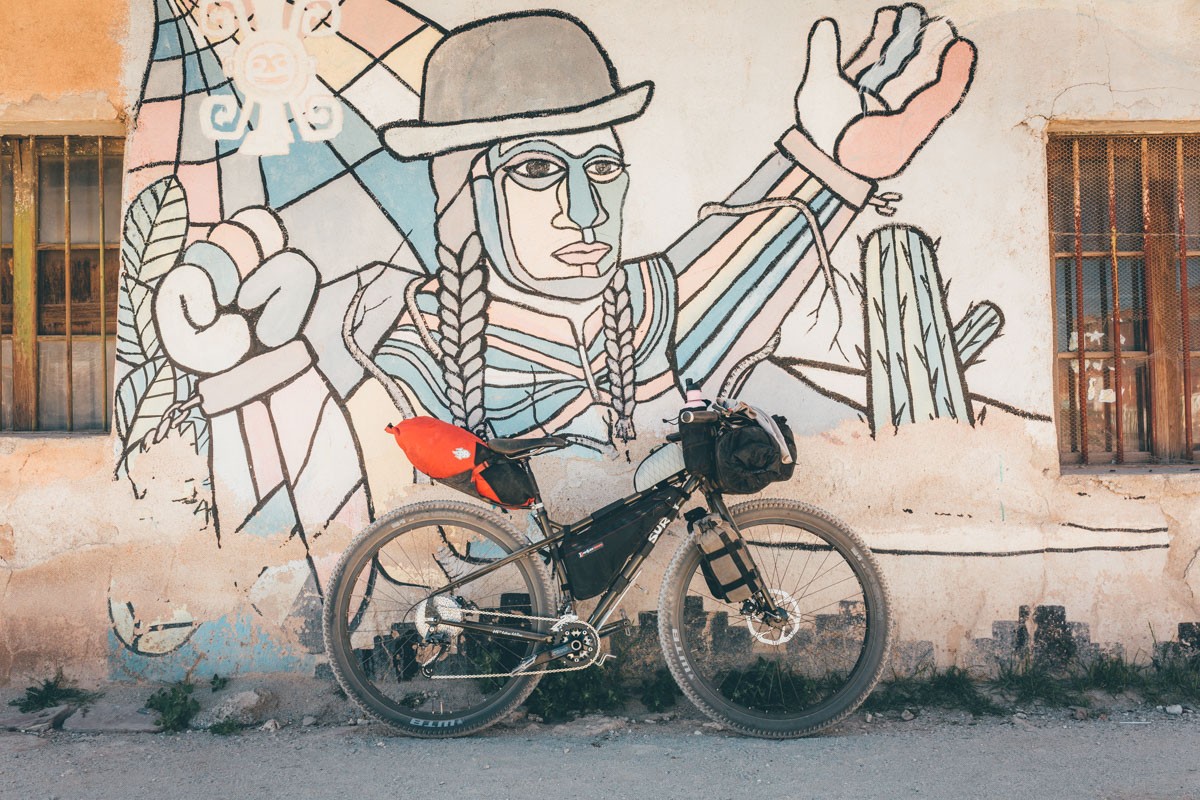
We segmented our traverse with a night camped behind Isla Incahuasi, a magnet for tourists visiting the area, thanks in part to its weird and wonderful inhabitants – a family of bizarre cacti that stand sentinel across this unlikely chip of land. There, we met up with Brian from San Francisco, a fellow fat biking bikepacker, who quit his job as an architect and is currently riding from Patagonia to Colombia and beyond.
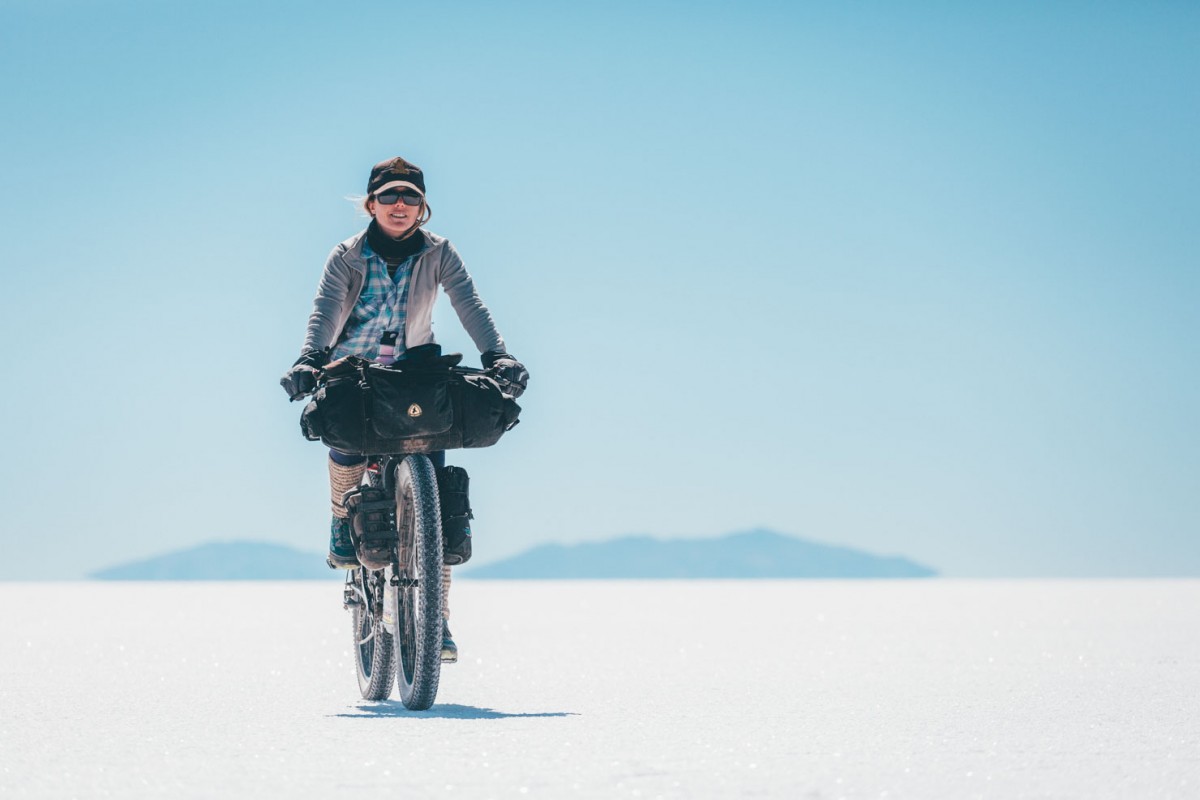
With the wind in our favour, and like a scene from a toddler’s edit of Mad Max, we sailed across this cinematic salar for our final day, music blaring from the trailer. There was an undoubted sense of relief at having completed the crossing, but also some sadness to be leaving such a magical land, despite our many hardships. It certainly hadn’t been an easy journey. The high altitude sun had cracked our lips and chapped our cheeks. It had baked the skin on our arms. And it had peeled our noses raw. But we’d made it. The sense of accomplishment, and the memories of this poetic, bleached white canvas, will remain imprinted within us long after our tired bodies have healed.
Tips for family bikepacking in Bolivia
- The ride took us 7 days in total. We broke up a few longer days with a couple of really short ones, so Sage had plenty of time to stretch, run around, and be a toddler. More info on the route to come, or check out Andes by Bike in the meantime.
- Bring broad rimmed hats – like Sunday Afternoon – high SPF suncream and good quality sunglasses.
- Ride from Sabaya to Uyuni to be in the best direction for the prevailing North Westerly winds.
- Thule Chariot trailers, like the Cougar, are great for this kind of varied terrain. With its plush suspension, Sage sleeps through the bumpy stuff. We time the majority of our riding with his naps.
- As we didn’t have room to bring a child seat, we adapted our trailer so Sage could stand too, in places we deemed sufficiently safe to do so. There’s not much in the way of traffic on the Salar!
- Tunes and audio books came courtesy of the incredibly small yet hardy Outdoor Tech Buckshot.
- Dehydrate some veg beforehand. Jerky is good for adding to campsite quinoa soups too. Local provisions can be relatively basic. Pack vitamin supplements and rehydration tablets like Nuun.
- Bring games to play on the Salar – a football, a frisbee etc… We bought our football locally for a few dollars.
- Layer up! It gets super cold at night, below freezing depending on the time of year. La Paz and Uyuni have a great selection of locally made, woollen items to supplement technical gear. At night, we wrapped Sage in a cosy Milk and Honey down sleepsack. We lavished Sage with a wardrobe of Patagonia clothing, just because they make such great kids outdoor gear.
- Bring a tent that can handle strong winds and cold temps for camping out on the Salar.
- Although bottled water is readily available, best to pack a filter to save on trash. We love the easy to use Platypus Gravity Works, backed up by a USB-powered Steripen Freedom.
- Have plenty of capacity for H20. We hauled up to 12L between us – MSR Dromedary bags are great for family use.
- For off the bike adventures, the Onya Baby carrier was well worth having. 3 year old legs get tired… This harness is comfy and relatively light.
- Uyuni’s main plaza has an incredible, two story high slide, the social gathering point for kids in town. The train cemetery is wonderful for exploring too, if a little precarious.
- We picked up flights with LAN from LA to La Paz for $550 – bikes (and the trailer) go free.
- To get to the start point of this route, catch a bus from La Paz to Oruru (3-4 hours). Then hop on another bus to Sabaya (3.5 hours). It’s generally not a problem to shoehorn bikes into the belly of the bus. Hotel Floryda in Oruru is a great place to stay to break up the journey.
- Although I was pulling an awful lot of weight – the trailer, Sage and water alone weigh 40kg – for the most part, the terrain is very flat, which makes this trip very do-able.
- A mid or full fat is really useful for Bolivia, especially if you aim to stray off paved roads. Expect sand and corrugation.
- When you’re done, enjoy the all-you-can-eat buffet breakfast at Minute Man Pizza in Uyuni. It’s incredible!
With thanks
To Surly for dreaming up the mid fat platform – so well suited to backcountry touring in South America – and the awesome ECR, which Nancy has been thoroughly enjoying. To Daniel Molloy for creating the supremely versatile, Rohloff-driven Tumbleweed, which has both slayed trails and hauled a Thule Cougar loaded to the gils with gear, supplies and toys. To Hyperlite Mountain Gear for lending us a featherweight Ultamid 2. And to my local bike purveyor, The Broken Spoke, Santa Fe, for sponsoring me spare parts for this ride.
Please keep the conversation civil, constructive, and inclusive, or your comment will be removed.







